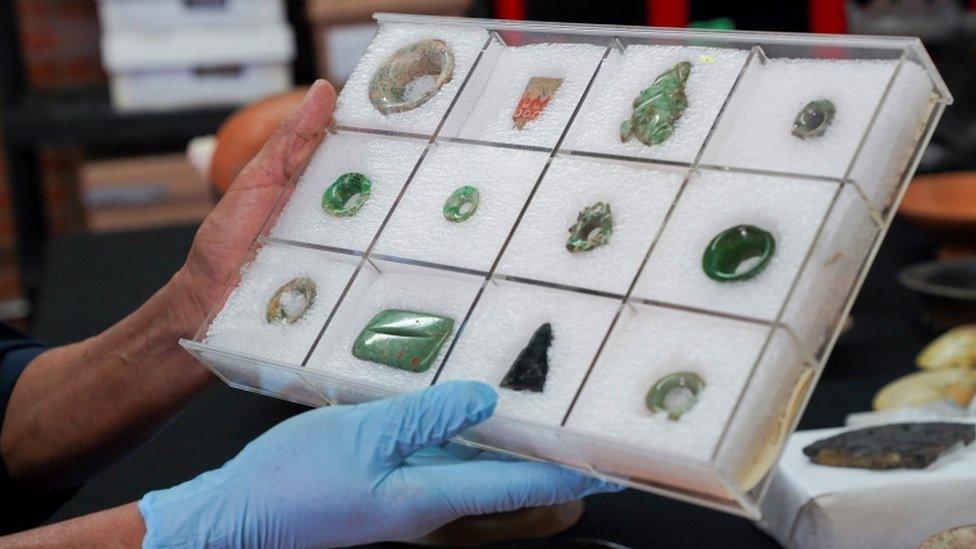Aztecs: Thousands of artefacts have been discovered under a pyramid in Mexico
- Published
- comments

This jade jewellery was discovered in the tunnel
Archaeologist Sergio Gomez has been searching for artefacts buried deep beneath a Mexican pyramid for more than a decade.
Over the years, he's managed to recover lots of sacred artefacts which are believed to have been placed there by Aztec priests around 2000 years ago.
The objects were found in a sealed tunnel under a pyramid called the Temple of the Feathered Serpent in the ancient Mexican city of Teotihuacan.
So far, more than 100,000 objects from the tunnel have been recorded and the archaeologist spends the majority of his time studying the many incredible treasures he and his team have been able to recover.
What has been found at the Pyramid of the Feathered Serpent?
Segio Gomez began excavating the tunnel more than a decade ago
The volume and variety of objects hidden in the sealed tunnel has shattered records for discoveries at the ancient city, which is now a big tourist attraction just outside modern-day Mexico City.
"It has been almost 12 years of continuous research and exploration," said Gomez. "During these 12 years, we have discovered many objects with unique texts and materials in an excellent state of preservation, which broadens the perspective of what we initially thought was the tunnel."
The objects found range from finely-carved statues, jade jewellery and giant shells, to painted ceramics as well as thousands of wooden and metallic objects that have almost all remained in tact over the years.
Until recently, many of the artefacts discovered by Gomez and his team hadn't been reported. On a recent tour, the archaeologist showed off some of the items which were all used for ancient ceremonies and found along the length of the 100-metre-long tunnel and in three chambers directly under the pyramid.
What was the tunnel in the ancient pyramid?
More than 100,000 items were found
The tunnel itself was also designed to impress, with the walls and floor coated with iron pyrite, a mineral also known as fool's gold because of its similarities to the precious metal.
"We can imagine when the priests entered with a torch how it would have sparkled as the flame moved," said Gomez.
The space is believed to have been in use for more than two centuries through 250 AD and the city of Teotihuacan where the pyramid was built was home to as many as 200,000 people who mostly lived in multi-family stone compounds painted with colourful murals.
Ceremonies in the tunnel were carried out to offer gifts to the gods of the underworld, or to the city's main deity the storm god.
Giant shells were found in the tunnel wit carvings on them
The Aztecs are believed to have started off as a nomadic tribe in northern Mexico who came to a place which was then known as Mesoamerica around the start of the 13th century.
The Aztecs built a successful and powerful empire in the area now known as central Mexico.
This group were warriors, hunters and artists, and they're believed to have been the first people to discover chocolate!
Why are the archaeologists excited about flowers?
A bouquet of flowers weas among the artefacts found
Several bouquets of flowers which are thought to have been used during the ceremonies were among the many items found beneath the pyramid, a discovery which excited the archaeologists.
"What surprised us the most and for which we are very grateful is that at the end we found four flower bouquets. The bouquets are perfectly well preserved, and you can see how they were tied," said Gomez.
"We even found the ropes with which they were tied. We do not know what type of flowers they were, but the bouquets are very well preserved.
"We were able to see some leaves, which will allow the biologists to identify what type of flowers were used for this ritual. If we can identify the type of flowers, we will be able to know what time of the year it could have happened because that is when they used these flowers."
What do you think of these incredible discoveries? Let us know in the comments!
- Published11 February 2021
- Published23 April 2016
- Published16 June 2021
